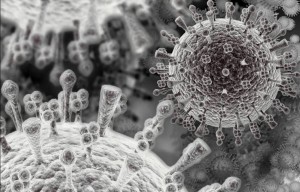Last night at The New Dowse, the topic of the monthly Lower Hutt Cafe Scientifique focused on swine flu – what it is, how it differs from previous influenza A H1N1 outbreaks, and what might be expected from it.
Questions were put to Dr Anne La Flamme, an immunologist and Senior Lecturer at Victoria University’s School of Biological Sciences. Dr La Flamme is particularly interested in the body’s immune responses with reference to auto-immune problems, and was able to provide an overview of the body’s response to swine flu, as well as context on previous outbreaks.
 An excerpt from the discussion:
An excerpt from the discussion:
Q: Have you seen any research showing estimated mortality in New Zealand over the course of this pandemic? I’ve seen a figure of 1 in 10,000, which would come to about 500 people. Have you seen any firmer figures than that from the ministry of health or anyone else?
Dr La Flamme: I don’t know as far as New Zealand goes, but if you look at the States, which has larger numbers to deal with, I think they’ve had about 263 deaths over about 40,000 infected and that equates to a fatality rate of about 0.6%. When you go back to the ‘mother of all pandemics’, that was greater – 2.5% – so we’re far below that, but normal influenza A epidemics, when you’re looking at the fatality rate, tend be less than 0.1%. So it is a more virulent strain, and again, part of that virulence is now targeting a different population as well.
Q: How many people die normally, from normal flu?
Dr La Flamme: Normally, it’s very low – it’s below that 0.1%, and if you look at those that die, for the most part they’re going to be either very young or very old. And it’s going to be people that are somewhat immuno-compromised in some way so their immune system isn’t functioning fully. It may be that their lungs are not functioning fully as well, such that complications arise because again, with influenza A, most of the time it’s the complication, not the virus itself, that’s causing the problem.
Q: Have there been more deaths this year from flu than normal?
Dr La Flamme: Yes, there have. But what has happened worldwide is that we used to have a circulation of a H1N1, and H2N2 and the influenza B – for the most part, all we see now is this novel H1N1. That’s all we’re seeing – it’s very rare that you see any of the other ones. They’re probably still out there, because they need to maintain themselves in a reservoir, but they’re just not being picked up. Again, they may not be being picked up because those people are staying at home and fighting it off and it’s the one that is more virulent that is showing up at the hospitals and being tested.
The whole meeting, with questions and answers, can be heard below.
Part I
[audio:https://www.sciencemediacentre.co.nz/wp-content/upload/2009/07/cafe-scientifique-30-july-09-swine-flu-dr-anne-la-flamme-part-i.mp3]Part II
[audio:https://www.sciencemediacentre.co.nz/wp-content/upload/2009/07/cafe-scientifique-30-july-09-swine-flu-dr-anne-la-flamme-part-ii.mp3]